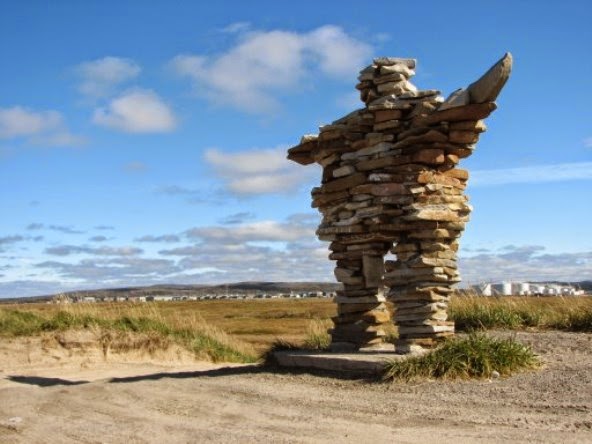Rapid changes have modified the Inuit nomadic way of life
The well-being of the Inuit, both physical and mental are a result of many factors including but not limited to the fact that rapid changes have modified the Inuit nomadic way of life over the past last 50-100 years. Two generations have passed since the Inuit in Canada were moved into permanent settlements; it is not considered a long enough time to change the ways of a people.
Inuit confront the highest cost of living with the lowest national income
Traditionally, women were responsible for maintaining their families and social order while the traditional roles of men as hunters and providers made them derive satisfaction for being able to take care of his family. The rapid changes in their lifestyle have accentuated the erosion of traditional culture, knowledge, practices, lifestyles and roles within the family and community. Despite significant progress made in communities, Inuit continue to confront the highest cost of living with the lowest national income.
Inuit combat the issues of alcohol and drug abuse
While their nomadic lifestyle on the tundra represented many challenges and times of great hardship, strong bonds of kinship and greater equality between the genders, the Inuit knew they could turn to one another in times of hardship. Today’s Inuit have to combat the issues of alcohol and drug abuse and the unfortunate events that are products of that abuse, including misuse of firearms. Kinship is taking a second place as their traditional family structure is disrupted, robbing parents of their authority, replacing Inuktitut with English, and leaving young people aimlessly stranded between English and Inuit cultures.
The aim of parenting is to nurture, protect and observe
Children are still revered by their families and communities. It is a rejoicing event as they bend their heads over the little ones and kiss their cheeks avidly. One fascinating aspect of raising children within the communities is that the Inuit are not anxious like we are. The children are in their mothers’ amauti until the end of their second year. Inherent in the process of raising children are a set of role expectations for those connected with the child. In the Inuit way, the aim of parenting is to nurture, protect and observe so as to create a path in life that is uniquely fitted to that child.
The dislocation into modern facilities, our western models of governance, the introduction of the wage economy, the imposition of an education and health and social service delivery, has many men and women feel expropriated from their traditional roles.
Many Inuit have had the experiences of forced attendance at Residential Schools. This forced education away from their homes has prevented those children from learning about positive parenting from their own parents and therefore many have experienced difficulty parenting their own children as adults.
Major factors such as inadequate and overcrowded housing, high rates of unemployment and poverty, low educational attainment, food insecurity and problems such as substance abuse, the high rates of suicide have contributed to Inuit regions having the highest rates of violence in Canada. Abusive behavior takes many forms: verbal, mental, physical. The domestic violence, the inequalities between men and women, the lack of employment opportunities and training are all factors which contribute to a heightened rate of depression, trauma symptoms and self-harm of mothers and children. Should anyone live in such circumstances, the experience of a loss of control in mothering would appear difficult to do at best, and totally distressing at times.
My project aims at raising awareness of the unique circumstances and priorities of Inuit women. In the Nunavik communities, the mothers who have children have to work around the fact that they often live in a house with 10-15 people and are viewed as responsible for the safety of their children. Think about it: how do you think raising children would evolve if we were to live in such a crowded space?
In that context, there are various risks factors. The Inuit mothers meet challenges and difficulties associated with these circumstances. Inadequate living conditions as in overcrowding (12-15 people in a two-bedroom unit) fuel other social conditions. Women, and children, who are experiencing violence and abuse in their homes seldom have another place in their community to seek safety.
Many communities across Northern Quebec do not have a safe shelter for women, and often the homes of family and friends are also overcrowded.
A plane ticket to another community may cost thousands of dollars, which is out of reach for most women particularly in times of crisis. For Inuit women, this can mean there is literally nowhere to go to find safety, and many women have lost their lives to family violence. Some have hit skid row after coming south with nowhere to go either. When that happens, the lives of their children are turned upside down.
Given the interconnectedness and interrelatedness of the people of the northern communities, what one experiences, all may experience. The lives of many people in the Northern communities are also adversely affected by the unemployment situation. Money issues can spark other stresses. Children are caught in a cycle of actions and reactions, based in anger or despair, drawing them in and affectively continuing the cycle into the future.




With regard to violence the Inuit often say, “it’s all talk and no action.” Violence is 13% higher than in the rest of Canada, women and children are most often the victims of violent acts. Violence toward women is a high priority issue. More needs to be done, now. Sustained efforts and adequate resources are urgently required.
ReplyDelete